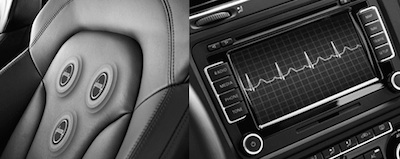 In the UK Nottingham Trent University researchers, Professor Tilak Dias and William Hurley are launching a study in collaboration with semiconductor company Plessey Semiconductors to study the efficacy of an electrocardiogram (ECG) system embedded into the the driver’s seat of cars, according to a report from the Telegraph.
In the UK Nottingham Trent University researchers, Professor Tilak Dias and William Hurley are launching a study in collaboration with semiconductor company Plessey Semiconductors to study the efficacy of an electrocardiogram (ECG) system embedded into the the driver’s seat of cars, according to a report from the Telegraph.
This system, called Electric Potential Integrated Circuit (EPIC) monitors heart rate and alertness to detect when the driver has fatigue and may fall asleep at the wheel. The system could also be used to determine the car’s occupancy and adjust the ride, handling, and air bag deployment.
The Technology Strategy Board gave the study over $150,000 (88,000 British pounds) in grant funding to test the technology.
In 2012, MobiHealthNews reported that this technology was originally developed at The University of Sussex in partnership with Plessey, but Plessey now has an exclusive license. At the time the company said it wanted to see the sensors used in ECG equipment by next year and expected car companies to bring it to market sometime in 2014. The company was in talks specifically with “high end” car manufacturers at the time.
In 2011, two other car companies, Ford and Toyota demoed health sensing features built into their cars.
In May of that year, Ford researchers announced they were working on a car seat with a built-in heart rate monitor. The car seat monitored a driver’s heartbeat through six sensors on the surface of the backrest that detect electrical impulses from the heart. Ford said it wanted to help drivers better manage their health, but also reduce car accidents that might be caused by the effects of chronic illnesses.
Then, a few months later, Toyota announced it was developing an ECG sensor embedded in a car’s steering wheel, which they demoed in a Prius. The company explained that contact sensors in the car’s steering wheel would be embedded with a single-lead ECG signal that could detect abnormal heart rhythm through the driver’s hands.













